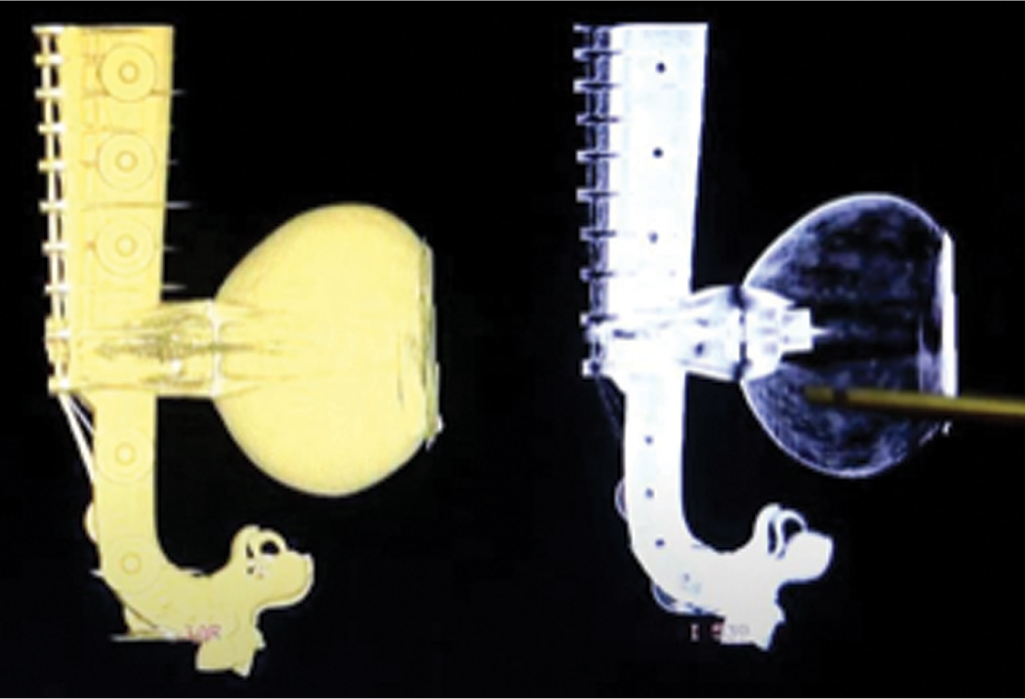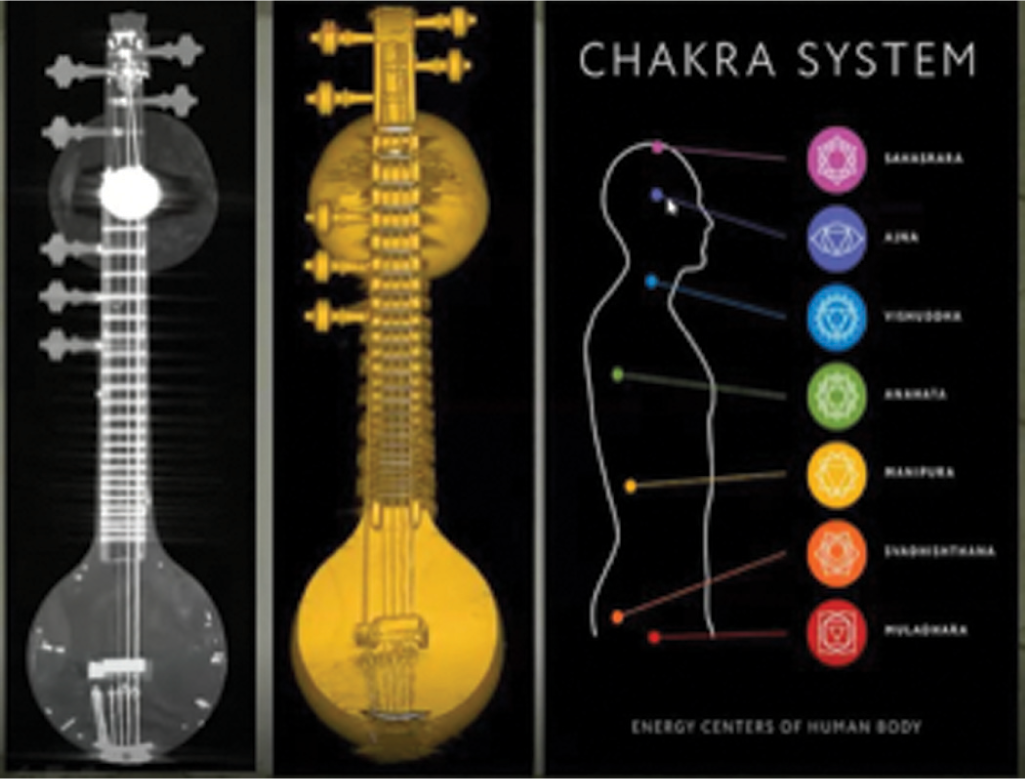Translate this page into:
Neuroradiology intertwined with the Veena: A radiologist perspective
Correspondence to RAJESH BOTCHU; drbrajesh@yahoo.com
[To cite: Durgaprasad BK, Iyengar KP, Lahari BD, Veenadhari B, Botchu R. Neuroradiology intertwined with Veena: A radiologist perspective. Natl Med J India 2023;36:114–16. DOI: 10.25259/NMJI_85_22]
Abstract
Music has had a distinguished position in human history; both as an art form and a medium for healing. Traditional Indian music has its roots in ancient scriptures of Vedas, which coincidently also form a basis of practice of Indian medicine. The Veena holds a revered place as an ancient plucked stringed instrument used in southern Indian classical music. The unique structure of the Veena has evoked descriptions and comparisons to the human body in various forms. We explore the resemblance of the Veena to human anatomy and provide a neurological correlation from a radiologist’s perspective.
INTRODUCTION
Indian music is rooted in spirituality, creating a mood of meditation, self-reflection and introspection. Realizing the influence of music on emotion and mind, music therapy has been practised in ancient India and continues to influence modern medicine.1,2 Indian classical music has two major traditions: the northern Indian classical music tradition is called Hindustani, while the southern Indian expression is called Carnatic music. It is characterized by intricate, subtle melodies and includes complex rhythms.3 The Veena is a traditional stringed melody instrument which often forms the central piece of a music concert. It is usually accompanied by a combination of other percussion or drone instruments and a soloist (instrument or vocal) in a small ensemble. The intertwined combination of the traditional string instrument and the instrumentalist leads to the performance of devotional music.
The structure of the Veena in its current form can be attributed to Raja (King) Raghunatha Nayak of Tanjavur in Tamil Nadu (1600–34) during the 17th century.4 Most of the features he envisaged still form the core of the classical Tanjavur acoustic Veena. However, contemporary solutions using electrical amplification and digital technology have led to the development of some modern versions of the Veena.
Human anatomy is the study of the structure and organization of the human body. An understanding of anatomy is necessary to the practice of medicine. We extrapolate the structure of the Veena to the anatomy of the human body and highlight a scientific reasoning to understand similarities in both.
-
The anatomy of the Veena. Components of the Veena—The Veena is one of the most ancient string instruments of India and considered to be the primary instrument of Indian classical music. The Veena has evolved over several centuries as the human body through several innovations and modifications.4 Its features/components and their comparisons to the human body include (Fig. 1):
1.1 Length and composition. The traditional Veena is 1.5 m long and is made from jack wood.
1.2 Head. The Veena has a large resonator box made of a hollowed-out wood, which resembles the human cerebrum.
1.3 Neck and body. The large resonator box continues distally or to the right in the form of a thick neck and a tall body, the tail end of which is curved into the shape of head of a dragon. The anatomical resemblance of the neck and body is the ‘Fret-board’ with 24 frets, which correlate to the 24 unfused vertebra in the spinal column. The frets are embedded on a base of wax mixed with charcoal powder. The sacrum and coccyx in humans are fused. The curved tail on the Veena symbolizes the fused sacro-coccygeal complex.
1.4 Spinal cord and the nerve plexus. Melody of the Veena is produced by the four playing metal strings that run above the frets stretched over a wide bridge. Three other rhythmic strings run alongside the neck of the instruments. The total of seven strings signify the most important component of neuro-anatomy and embody the spinal column with its associated neural plexuses.
1.5 Gluteal region. The second resonator box is used as a ‘support box’ to balance the instrument on the lap. It represents the gluteal region in the human body (Fig. 2).
-
Neuroradiology of the Veena. The image analysis of the Veena provides interesting observations of the instrument to the neuroradiology features of the human spine. Various imaging modalities can be undertaken to provide such an analysis. However, plain X-ray is not able to provide a holistic image. Magnetic resonance imaging (MRI) analysis is not able to deliver a structural demonstration as of the Veena as imaging is affected by the ferro-magnetic nature of the strings. Metal artefacts due to the brass and bronze elements are also not complimentary. Computed tomography (CT) image of the Veena is made possible by the ‘volume rendering’ software. Image analysis is possible on comparable axial/sagittal and coronal views of both the Veena and the whole spine. The sagittal plane image of the Veena and of the whole spine of the human body are the most revealing (Fig. 1). The large resonator box corresponds to the brain. The 24 frets resemble the 24 unfused vertebrae in the spinal column, i.e. the cervical, thoracic and lumbar spine. The curved tail on the Veena epitomizes the fused sacro-coccygeal complex. An interesting observation is the relationship between the intervertebral disc space spacing between the various parts of the spinal column and their correlation with the inter-fret distance. In humans, the intervertebral disc space reduces as we move from the lumbar region to the cervical spine. Similar is the case with the Veena. As we move from the left to the right or inferior to the top part of the Veena, the inter-fret distance gradually reduces as seen in the human spinal column. This humanoid resemblance is reinforced by the placement of the 24th fret on the Veena. The 24th fret (the last fret) on the Veena represents the most melodious and is ‘plucked’ to reproduce its best sound. Its place on the Veena resembles the first cervical vertebra of the humans. This level corresponds to the brain stem which holds the most important and key functions of the human system in the form of the vaso-motor, cardiorespiratory centres.
The seven strings represent the seven ‘chakras’ in the human body. Described in the ancient Raja Yoga, the seven chakras are the main energy centres of the body—a complex network of energy channels.5,6 They are supposed to hold the spiritual nervous system and are responsible for the harmony that exists between the physical body, mind and spirit. The medical background of these seven chakras is related to the seven important neural plexuses in the human body. These include the coccygeal, sacral, lumbar, cervical, brachial plexuses along with the sympathetic and parasympathetic systems (Fig. 3). These plexuses are crucial for normal physiological coordination in human beings. Similarly, the seven strings on the Veena represent the keys ‘neural network channels’ integral in the production of harmonized and synchronized music. The strings on the Veena are as fundamental to melodious rendition of music as is a good coordinated ‘chakra’ system in the humans.
Neuropathological correlation of the Veena. The placement of the frets on the Veena also have an important consideration. As eluded, the frets represent the human vertebrae. In one of the common spinal pathologies such as spondylolisthesis, there is an anterior or forward movement of the vertebra by varying degrees. Spondylolisthesis can lead to a ‘bad back’ with features of low back pain with or without neurological symptoms. Similarly, in the Veena if the fret moves even by a few mm, the instrument renders a painful, discordant music to the ears.

- Neuroradiology of spine of sagittal CT and T2W MRI along with corresponding features of the Veena

- Lower end of the Veena representing the gluteal region of human body

- Frontal view of the Veena along with its CT and seven significant neural plexus in human body corresponding to the different chakras
CONCLUSION
The venerable Veena resembles the human body in its anatomical structure and neurological system. A well-tuned Veena is like a ‘well-maintained’ human body. We have rediscovered the structure of the Veena from the Vedic days and have suggested a scientific reasoning to the components of the instrument. The ‘frets’ and ‘strings’ on the Veena need to be fine-tuned to deliver melodious music like the neurological system for a well-coordinated human function.
Conflicts of interest
None declared
References
- India's rich musical heritage has a lot to offer to modern psychiatry. Indian J Psychiatry. 2015;57:210-13.
- [CrossRef] [PubMed] [Google Scholar]
- Music for healing: From magic to medicine. Lancet. 2010;376:1980-1.
- [CrossRef] [PubMed] [Google Scholar]
- Variation and process in south Indian music: Some kritis and their sangatis. Music Theory Spectrum. 2001;23:74-89. Available at www.jstor.org/stable/10.1525/mts.2001.23.1.74 (accessed 29 Aug 2021)
- [CrossRef] [Google Scholar]
- Vibro-acoustic modeling, numerical and experimental study of the resonator and its contribution to the timbre of Sarasvati veena, a South Indian stringed instrument. J Acoust Soc Am. 2021;149:540.
- [CrossRef] [PubMed] [Google Scholar]
- Chakra talk: Exploring human energy systems. Holist Nurs Pract. 2005;19:94.
- [CrossRef] [PubMed] [Google Scholar]
- Improving quality of life using compound mind-body therapies: Evaluation of a course intervention with body movement and breath therapy, guided imagery, chakra experiencing and mindfulness meditation. Qual Life Res. 2008;17:367-76.
- [CrossRef] [PubMed] [Google Scholar]




